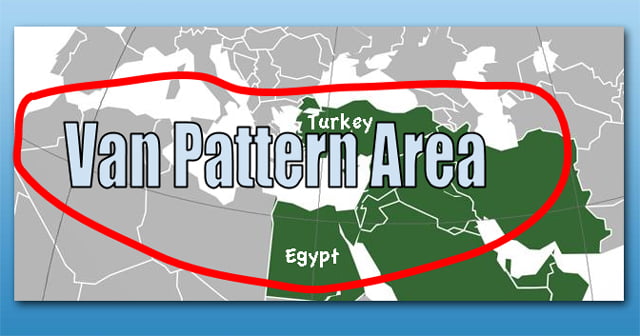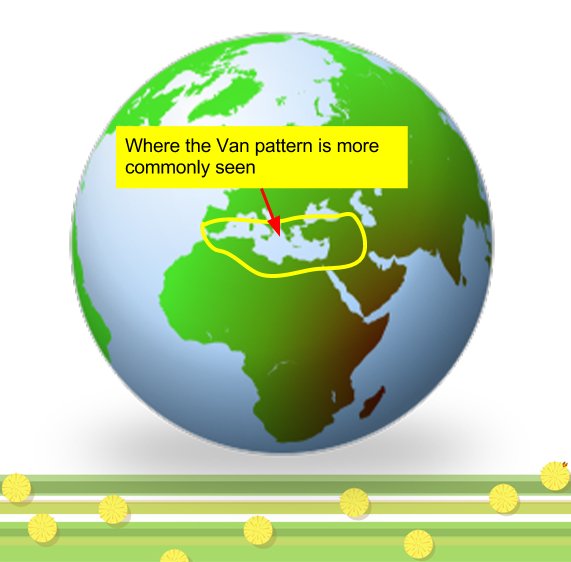
The Van pattern is named after Lake Van in eastern Turkey. It is close to Mount Ararat, the site of Noah’s Ark. Local legend says that when the Ark came to rest on the mountain after the flood receded and as the cats left the Ark they were blessed by Allah. The patch of auburn hair on the forehead and tail was were they were touched.
It is a very particular coat pattern. In summary it consists of a white body with coloured areas limited to the head and tail as seen in the photo above.
American Breed Standard
The Cat Fanciers’ Association breed standard for the Turkish Van defines what the Van pattern is. The cat’s body should be chalk white (due to the presence of the piebald gene – also called the white spotting gene) with an inverted V pattern around the ears and forehead and a coloured tail. The colours for the inverted V pattern and the tail are red (orange) black, blue (dilute black), cream (dilute red?). The colours can be solid or tabby. The association allows some dark spots on the chalk white body but prefer an all-white, clean looking body. The original colouring of the extremities was auburn (dark ginger) but breeding has added other color forms.
Turkish Van
It is the coat that adorns the Turkish Van cat according to the largest cat association in the world. The Van pattern is what distinguishes the Turkish Van from other cat breeds. Sometimes people refer to the ‘Van Cat’ which is a shortened name for the Turkish Van. In Turkey it is called the ‘Van Kedi’.
However, it is an slightly artificial breed standard. It is a Western creation probably born out of the fact that the first Van cats to make it to the West had these coat patterns. Lois Miles, an American cat breeder in 1989 felt that it was purely accidental that the original pair of Turkish Van cats brought back from Turkey to England in 1955 had the Van Pattern in auburn. These markings became enshrined as synonymous with this breed in the West but in Turkey this is far from the case.
Turkey
In Turkey, the Turkish Van is said to be the same cat as the Turkish Angora and you will see these cats in a wide range of colours and coat types. You will see the Van pattern but it is not the only coat type. Perhaps the Turkish people prefer predominantly white cats but that is not the only colour. In fact Dr Morris in Cat World tells us that when feline expert Roger Tabor visited Lake Van and discussed the breed with local people they considered an all-white animal to the the Turkish Van. Cats in Turkey with the Van Pattern were considered to be inferior.
Whenever, I see pictures of street cats, also called community cats or feral cats, in the area I have selected in the maps below, I often see the Van pattern.
Mediterranean
The location of the origin of the Van pattern does seem to be centered around eastern Turkey but it spreads out substantially over many of the countries surrounding the Mediterranean Sea especially to the east and south.
That is my impression. It is not based on science and neither does the information come out of a book or website. It is simply what seems to be the case to me. I am happy to be corrected. Note: the pattern is not limited to this area. It just seems to be more common in this area.
I don’t think you will find any text or maps about where you are most likely to see Van patterned cats, namely: to eastern and southern Mediterranean – i.e. North Africa. The map, below, that I have made indicates where I believe you are most likely to see the Van pattern.

Associated: Mediterranean Cats and The Cats of Morocco.
Updated, different or better map:

Note: this was republished and added to on 16th August 2018 to bring it forward for subscribers which is why the comments have different dates. Many of the early pages (this one was written 5 years go) become semi-invisible. However, this page is found by Google search and presents on page one.


Absolutely beautiful cat and the fact that he was rescued makes him even more handsome to me. Classic Van coat. Top quality. And thanks a lot for showing us.
And one more showing off Creamsicle’s beautiful eyes.
Adding pic.
Here is a picture of the two I adopted. The van pattern is a boy named Creamsicle and the orange tabby a girl named Clementine.